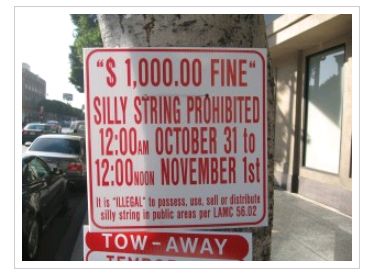
Halloween is coming up, and it is one of my favorite Silly String holidays. I was reading an article in Wired about the secret in Silly String tonight and it got me thinking about leveraging patents into other types of intellectual property.
Silly String was originally patented back in 1972. As described in Ms. Palmer's Wired Article, there is quite a lot going on in the can to get that perfect, light stream to shoot from the can.

According to Wikipedia, within a year after Silly String was introduced in the U.S., the propellant originally used was banned in the U.S. So we know that the composition changed, but it seems that Wham-O never filed an updated patent.
I'm not an expert on Silly String, but this means one of three possibilities to me: (1) the original patent still covered the updated formulation and propellant; (2) Wham-O didn't think the patent costs merited the return on investment of updating the patent; or (3) Wham-O decided that it would have more protection over the compound if it kept the update as a trade secret. Or, it could have been a combination of all three.
Let's consider why a combination of the first and third options is interesting. If you can figure out a way to obtain a broad patent over part of your invention (the can, the plasticizer, and the resin, and a broad category of propellants), then you can also keep the fine tuning adjustments as a trade secret that could last long after the patent expires (the exact ratio of ingredients, etc.).
Finally, and probably most importantly, is to pick a great trademark like SILLY STRING. The trajectory looks like this: patent protection can help keep competitors out in the short run (20 years from filing, upon grant of patent), trade secrets can help you refine your product and keep the best one in the market even after the patent expires, and trademarks can identify your product long after the patent expires.
Of course, before you begin your Silly String celebration this weekend, be sure to figure out if you have a local ordinance prohibiting it. According to Mother Jones, who I don't know and can't vouch for, the penalties for using Silly String during Halloween in Los Angeles are more severe that for "drunk hunting" or "breaking into a zoo enclosure." Of course, I'm not suggesting either of these as a great alternative to Silly String in downtown Los Angeles this weekend either.

The content of this article is intended to provide a general guide to the subject matter. Specialist advice should be sought about your specific circumstances.

